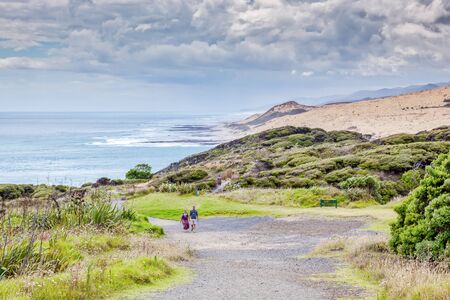Introduction to the Mourne Coast Path
Stretching along Northern Ireland’s south-eastern shoreline, the Mourne Coast Path stands as one of the region’s most breathtaking walking routes. Nestled between the rolling waves of the Irish Sea and the dramatic granite peaks of the Mourne Mountains, this coastal path offers a unique blend of rugged natural beauty and deep-rooted local heritage. For generations, both seasoned hikers and casual strollers have been drawn to its winding trails, which connect picturesque harbours, secluded coves, and charming seaside villages. The route itself holds a special place in the hearts of locals, serving not just as a scenic escape but also as a living testament to the area’s maritime history and vibrant culture. Whether you are seeking panoramic sea views or an authentic slice of Northern Irish tradition, walking the Mourne Coast Path promises an experience that is as enriching culturally as it is visually stunning.
2. Planning Your Walk: Routes and Essentials
Preparing for a journey along the Mourne Coast Path means more than simply lacing up your boots and heading out. The path offers a variety of sections, each with its own character and challenges, so careful route selection is essential. Whether you’re after a gentle stroll from Newcastle to Dundrum or planning to tackle the full coastal stretch from Rostrevor to Newcastle, it’s worth assessing your fitness level, available time, and appetite for adventure. Below, find an overview of popular route options:
| Route Section | Distance | Estimated Time | Highlights |
|---|---|---|---|
| Newcastle to Dundrum | ~6 km | 1.5–2 hours | Dundrum Bay, tidal mudflats, birdlife |
| Annalong to Bloody Bridge | ~8 km | 2–3 hours | Rocky shoreline, sea views, Annalong Cornmill |
| Rostrevor to Killowen | ~10 km | 3–4 hours | Carlingford Lough vistas, forest paths |
| Full Mourne Coast Path | ~35 km | 8–10 hours (or multi-day) | Diverse scenery, beaches, cliffs, villages |
Selecting Your Route Wisely
The Mourne Coast Path is not uniformly challenging; some sections are suitable for families and casual walkers, while others demand greater stamina and navigation skills. It’s advisable to check local tide times—certain stretches become impassable at high water—and always consult up-to-date Ordnance Survey maps (OSNI 29 or similar) before setting out.
Essential Kit for British Coastal Weather
The Northern Irish coast is notorious for rapid weather changes. Even in summer months, a calm morning can quickly shift to blustery rain by afternoon. Your kit should reflect this unpredictability:
| Item | Description/Tip |
|---|---|
| Waterproof Jacket & Trousers | Packed even on dry days; breathable fabric preferred. |
| Sturdy Walking Boots | Essential for rocky or boggy stretches; ankle support recommended. |
| Warm Layers (e.g., fleece/jumper) | Northern Ireland’s coastal wind can be bracing year-round. |
| Hat & Gloves | Packed regardless of season; mornings and evenings get chilly. |
| Map & Compass/GPS device | Mourne trails are well-marked but fog can roll in suddenly. |
| Sunscreen & Sunglasses | The wind deceives; UV exposure is real even under cloud cover. |
| Water & Snacks (Flapjack/Chocolate Bar) | Cafés may be few and far between outside towns. |
| First Aid Kit & Whistle | A safety must for rural UK walking routes. |
| Mobile Phone (charged) | No guarantee of reception everywhere; let someone know your plan. |
| Litter Bag (“Leave No Trace”) | Countryside code: take all rubbish home. |
Navigating Public Transport Links in the UK Countryside
The Mourne Coast Path benefits from decent public transport links by Northern Ireland standards, but it pays to check schedules in advance—especially on Sundays or bank holidays when services run less frequently. Local Ulsterbus services connect Newcastle, Annalong, Kilkeel, Rostrevor and other key towns along the route. For those coming from further afield, trains serve Newry and Bangor with onward bus connections. A typical approach is to park or stay overnight in one town, use public transport to your starting point, and walk back at leisure—a method favoured by seasoned British ramblers. Always carry a printed timetable or download the Translink app as signal can be patchy in rural areas.

3. Scenic Highlights and Local Wildlife
The Mourne Coast Path is renowned for its breathtaking views and distinctive features, making it a jewel of Northern Ireland’s shoreline. As you set out from the bustling harbour at Newcastle, you’ll immediately notice the dramatic sweep of Dundrum Bay, framed by the towering Mourne Mountains – known locally as “the Mountains of Mourne.” These rugged peaks often appear to tumble down directly to the sea, creating a truly iconic landscape.
One particularly striking section is Bloody Bridge, where craggy cliffs meet the crashing Irish Sea. Here, you can spot seabirds like guillemots and razorbills nesting on rocky ledges, while hardy gorse bushes and heather add flashes of yellow and purple along the path. Moving further along, you’ll come across Annalong Cornmill, a lovingly restored local landmark that speaks to the region’s heritage. This area is also dotted with ancient stone walls, locally called “drystane dykes,” which wind through green fields right up to the shore.
The coastal grasslands and saltmarshes are home to a variety of wildlife. Keep an eye out for grey seals basking on offshore rocks or dipping through the waves. During spring and summer, wildflowers such as sea thrift and cow parsley carpet the verges, attracting butterflies like the small tortoiseshell and painted lady. If you’re lucky, you might even catch sight of a red squirrel darting among the trees near Rostrevor.
Beyond fauna, natural landmarks abound: St John’s Point lighthouse stands sentinel at one end of the coast, its black-and-yellow stripes cutting a bold figure against the horizon. The ever-changing weather—one minute misty drizzle (“soft day,” as locals say), the next clear blue skies—adds to the path’s character and drama.
In sum, walking the Mourne Coast Path offers not only stunning vistas but also a close encounter with Northern Ireland’s rich natural tapestry and time-honoured local features—a genuine feast for both eyes and soul.
4. Quaint Villages and Friendly Pubs Along the Way
One of the true joys of walking the Mourne Coast Path is discovering the string of charming villages that dot the shoreline, each with its own distinct character and a warm Northern Irish welcome. As you meander from Newcastle to Rostrevor, you’ll encounter traditional tea rooms, classic fish and chip shops, and inviting pubs—each offering a taste of local hospitality and culture. Below is a curated guide to some must-visit stops along the route:
| Village | Tea Rooms | Fish & Chip Shops | Pubs |
|---|---|---|---|
| Newcastle | The Percy French Tea Rooms – Elegant afternoon teas with scones and clotted cream. | Doc’s Fish & Chips – Crispy battered cod served seaside. | The Anchor Bar – Classic British pub fare and live folk music. |
| Annalong | Harbour View Café – Panoramic sea views with home-baked cakes. | Annalong Fish Bar – Traditional chips wrapped in paper. | The Harbour Inn – Cosy fireside pints and hearty stews. |
| Kilkeel | Copperpot Tea Room – Loose-leaf teas and homemade traybakes. | Mourne Seafood Bar – Local catch, freshly prepared daily. | The Steaming Mug – Lively spot for real ale and banter with locals. |
| Rostrevor | The Old Schoolhouse Café – Afternoon tea in a historic setting. | Sands Fish & Chips – Famous for their mushy peas side. | The Kilbroney Bar – Welcoming atmosphere and traditional music sessions. |
A Taste of British Tradition
Stopping off at these establishments is about more than just refuelling—it’s an opportunity to immerse yourself in local life. Whether you’re enjoying a pot of English Breakfast tea in a sunlit conservatory or sharing stories with friendly regulars over a pint of stout, you’ll experience the unique blend of Irish warmth and British tradition that defines this region. Don’t miss out on regional favourites like soda bread, wheaten loaf, or a hearty ploughman’s lunch if you see them on the menu.
Practical Tips for Walkers
- Opening hours: Many rural tea rooms close by 5pm; plan your walks accordingly for afternoon treats.
- Pubs: While most are family-friendly during the day, evenings may be livelier and filled with local music—an authentic experience worth seeking out!
- Reservations: Popular spots can fill up quickly in peak season, especially on weekends—booking ahead is wise for larger groups.
- Cultural courtesy: Engage with staff or fellow patrons; locals are typically eager to share recommendations or tales from the Mournes.
Conclusion: More Than Just Scenery
The villages along the Mourne Coast Path aren’t just stopovers—they’re integral to the journey itself. Each offers a slice of Northern Irish coastal life, making your walk as much about heartfelt encounters and culinary discoveries as it is about stunning landscapes.
5. Weather Wisdom and Trail Safety
If you’ve ever heard the phrase “four seasons in one day,” you’ll soon find out how true it rings when walking the Mourne Coast Path. Northern Ireland’s weather is famously unpredictable, with sunshine, sea mist, rain showers, and gusty winds often making an appearance all within a single afternoon. To make the most of your walk and stay safe along this stunning shoreline, it’s crucial to prepare for every eventuality.
Essential Gear for All Conditions
Packing layers is key—think lightweight waterproofs, windproof jackets, and warm hats even in late spring or early autumn. Waterproof boots with a good grip are a must, as the path can be slippery after rain or along rocky sections. Many locals swear by quick-drying trousers and always carry a dry bag for electronics and maps. Don’t forget high-energy snacks and a refillable water bottle; the weather may cool you down but hiking here works up a real thirst.
Respecting the Elements
Pay attention to local weather forecasts before setting out; the Met Office app is reliable and widely used across the UK. If heavy fog descends, slow your pace and stick to waymarked trails—visibility can vanish rapidly along coastal stretches. In strong winds, take extra care near exposed cliffs and avoid venturing onto slippery rocks or tidal sections that may become dangerous. Remember, there’s no shame in turning back if conditions deteriorate; even seasoned walkers respect the Mournes’ power.
Seasonal Surprises: Embracing Nature’s Changes
Each season brings its own challenges and rewards. Spring carpets the coast in wildflowers, but paths can be boggy after winter rains. Summer offers longer daylight hours—perfect for lingering over views—but unexpected showers are still common. Autumn cloaks the hillsides in golden bracken, while winter walks reveal dramatic skies and crashing waves (just be mindful of shorter daylight hours). Locals recommend starting early whatever the time of year to make the most of clear spells and to keep an eye on sunset times.
By respecting the Mourne Coast Path’s ever-changing weather and preparing accordingly, you’ll not only enjoy safer walks but also discover why locals cherish this rugged stretch of shoreline through every season.
6. Sustainable Walking and Respecting Local Customs
As you traverse the breathtaking Mourne Coast Path, it is essential to consider your environmental impact and be mindful of local traditions. Northern Ireland’s natural beauty thrives when visitors adopt sustainable practices and respect the region’s rich cultural heritage.
Minimising Your Environmental Footprint
The Mourne Coast Path’s unique ecosystems are easily disrupted by careless behaviour. Stick to marked trails to prevent erosion and avoid disturbing sensitive habitats. Carry out all rubbish, including biodegradable waste, as even organic matter can harm native wildlife. Refill reusable water bottles at designated points and opt for public transport or car-sharing when accessing trailheads to reduce carbon emissions.
Countryside Etiquette
Understanding the “Countryside Code” is vital in Northern Ireland. Always close gates behind you, particularly on farmland sections, and never pick wildflowers or disturb livestock. Keep dogs under close control or on a lead, especially during lambing season, to protect both animals and local livelihoods. A simple greeting or nod to fellow walkers and farmers goes a long way in showing respect.
Respecting Cultural Heritage
The Mourne Coast is steeped in history, from ancient stone walls to centuries-old cottages. Refrain from climbing on monuments or removing artefacts, no matter how small. When passing through villages like Newcastle or Annalong, support local businesses by purchasing refreshments or crafts—this sustains the community and preserves traditional skills. Take time to learn about local legends and stories; they are woven into the very landscape you are exploring.
By walking thoughtfully and respectfully, you help ensure that future generations can experience the same awe-inspiring beauty of the Mourne Coast Path.
7. Finishing Touches: What to Do After Your Walk
Completing the Mourne Coast Path is a memorable achievement, and it’s well worth taking some time to wind down and savour the experience. Here are a few thoughtful suggestions to wrap up your journey in a way that truly resonates with the spirit of British walking culture.
Attend Local Events and Embrace Community
If your timing aligns, check out local events in the seaside towns along the route, such as Newcastle or Annalong. From traditional folk music sessions in cosy pubs to craft fairs and food markets celebrating Northern Irish produce, there’s often something happening that invites walkers to join in and connect with residents and fellow hikers. It’s a brilliant way to immerse yourself further into the culture and perhaps pick up a few local stories about the Mournes.
Places to Relax and Reflect
Treat Yourself to a Well-Earned Rest
After miles of clifftop paths and beach walks, consider rewarding yourself with a cuppa in one of the region’s inviting tearooms or a hearty meal at a local gastropub. Some walkers opt for a quiet moment on Murlough Beach or the gentle gardens near Dundrum Castle, where you can reflect on your adventure amidst peaceful surroundings. For those seeking comfort, several coastal B&Bs and boutique hotels offer sea views—perfect for unwinding after your trek.
Share Your Experience with the Walking Community
Join the Conversation
The British walking community thrives on shared experiences. Consider posting your route highlights, photos, and insights on platforms like Ramblers UK or regional Facebook groups dedicated to walking in Northern Ireland. Tagging #MourneCoastPath on social media helps inspire others while connecting you with fellow enthusiasts who appreciate tales from the trail.
For something more traditional, jot down your thoughts in a walking journal or submit an account to local magazines or newsletters—many love featuring personal reflections from visiting ramblers.
Give Back: Leave No Trace & Support Conservation
A final tip: support ongoing conservation efforts by respecting ‘leave no trace’ principles and considering a donation to organisations protecting this beautiful coastline. This small gesture helps ensure future generations can enjoy the path just as much as you have.
Finishing the Mourne Coast Path isn’t just about ticking off another walk—it’s about becoming part of a wider community of explorers who cherish Britain’s natural beauty and traditions. However you choose to celebrate, make it meaningful, mindful, and uniquely yours.

